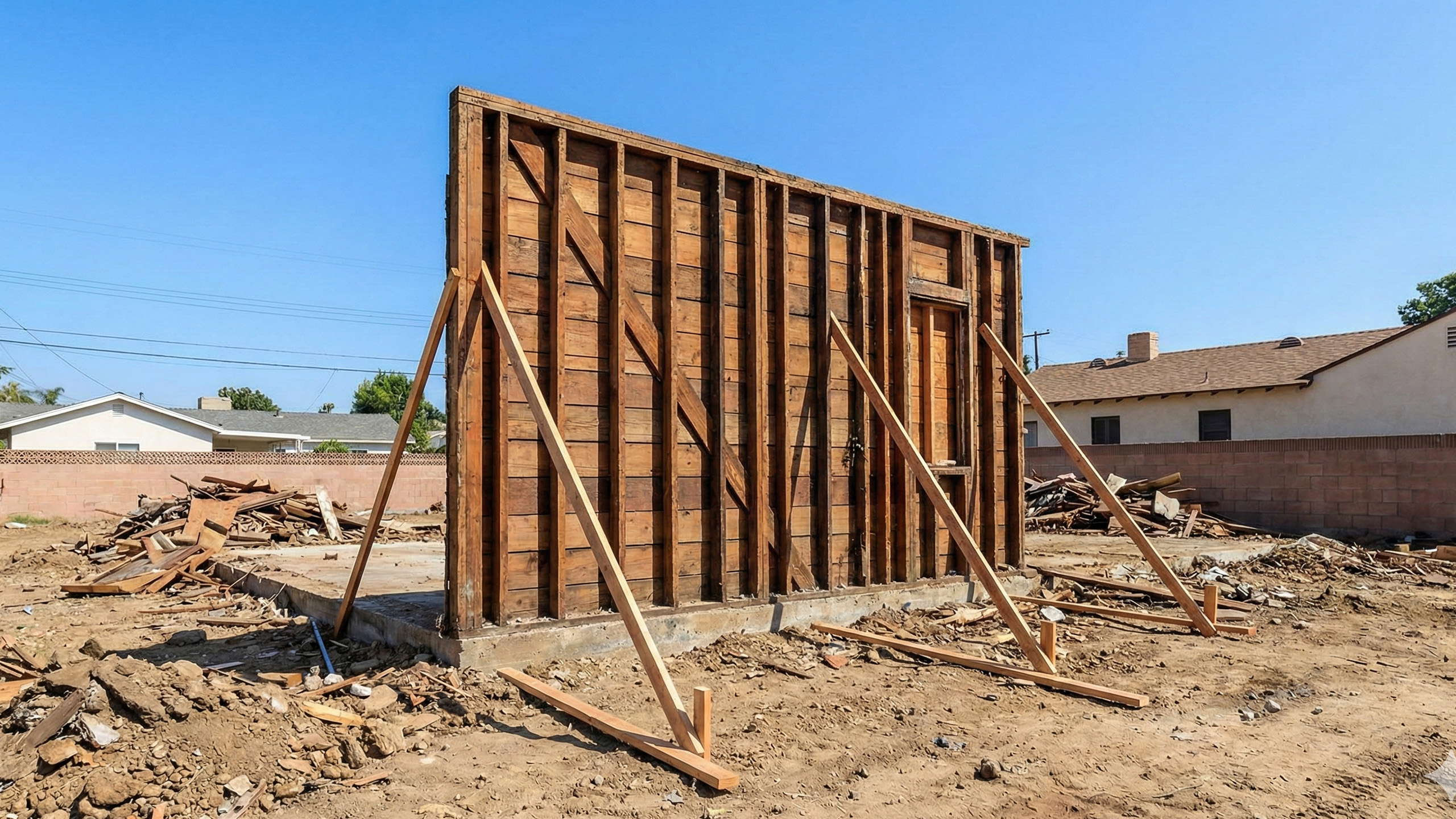Are the recent headlines about ADU sales too good to be true?
Recent reports have announced promising news for California’s homeowners: a new law now allows the separate sale of Accessory Dwelling Units (ADUs). Assembly Bills are rarely simple, so let’s look further!
As Design-Build contractors with extensive experience in residential projects across Southern California, we at Letter Four have become very familiar with the regulations overseeing ADU development. We’ve analyzed the bill in question, and have identified some important things you will need to consider before planning to sell your ADU.

Understanding California's Assembly Bill 1033 (AB 1033)
Under current laws, there's a general rule that says you can't sell an ADU on your property separately from your main house. However, there are some exceptions to this rule. One exception allows you to sell the ADU separately if you meet certain conditions, such as:
- The ADU was built by a nonprofit organization that qualifies under the law, and…
- The property is owned in a specific way called "tenancy in common," which is a form of shared ownership that is detailed in a legal document.
AB 1033 introduces new standards for potential changes to zoning codes, allowing local governments to make new rules that would enable homeowners to sell their Accessory Dwelling Units (ADUs) separately from the main residence (akin to selling condominiums). However, this newfound ability comes with several considerations.
Partition In-Kind of Single Family Residential Properties
AB 1033 allows for a simple partition “in-kind” for single-family homes, where ADUs can be sold separately to resolve partition actions. So what does that mean?
A partition action is a legal process used to divide property owned by multiple parties. When co-owners of a property cannot agree on the use or disposition of the property, one or more of the owners can file a partition action in court, with the intent to have the property divided.
In the context of AB 1033, a partition action could potentially be resolved by selling an ADU separately from the main residence, thus providing each owner with their share of the property's value without having to sell the entire property. It is a pathway for co-owners to receive their equity in the property, especially beneficial when the ADU represents about 15 to 30% of the value of the entire parcel.

Local Government Opt-In
The new law requires local governments to opt into the ADU-As-Condominium approach for it to be applicable in their cities. This means that the provisions of AB 1033 may not be available to all homeowners across California, but rather those residing in participating cities.
AB 1033 will go into effect on January 1st, 2024. While Los Angeles is expected to opt in, homeowners must wait until it’s made official.
To be clear: separate ADU sales will only be available to homeowners if their local municipality adopts a new ordinance under AB 1033.
Qualifying ADUs for Sale
Local agencies can allow ADUs and main homes to be sold separately as condos if they follow certain rules, including:
- Complying with the Davis-Stirling Common Interest Development Act.
- Meeting all requirements of the Subdivision Map Act and local subdivision laws.
- Passing a safety inspection before the condo plan is recorded.
- Getting consent from any lienholders (those who have a financial claim on the property) before recording the condo plan. Lienholders can set terms or refuse consent.
- Creation of the condo plan: a detailed map that shows the individual units and common areas.
- Creating a maintenance agreement for HOA for common areas, like a shared driveway, outdoor space or amenities
Designation Areas for ADUs
Moreover, local governments can decide where ADUs are allowed based on the availability of water and sewer services, and how they might affect traffic and public safety. If the local government doesn't handle water or sewer services, they must secure the cooperation of the acting authorities to make sure these services can support the ADUs.
All of this means that even if your city has opted in, your property may still not be eligible if it is in a non-designated location.
Is Los Angeles "Opted-In" Yet?
The biggest question for California homeowners is: Can I actually sell my ADU today? Under AB 1033, the state allows for the separate sale of ADUs as condominiums, but only if the local city or county passes its own ordinance to "opt-in."
As of late 2024 and early 2025, The City of Los Angeles is actively moving toward full adoption via the "Missing Middle LA" program. The Planning Department has been instructed to create the zoning amendments necessary to allow ADUs to be sold separately. However, this is not a "wild west" scenario. To sell an ADU, your property must undergo a formal Condominium Conversion.
What this means for you:
- Separate Utilities: You will likely need separate meters for water, gas, and electricity for each unit.
- Homeowners Association (HOA): Even for a single lot with two units, a formal HOA must be established to manage shared spaces (driveways, roofs, and yards).
- Lienholder Consent: If you have a mortgage, your bank must agree to the subdivision of the property into a condo map.
At Letter Four, we are tracking these local ordinances weekly. If your goal is future resale, we can design your ADU today with the necessary structural and utility separations to ensure it's "sale-ready" the moment your local neighborhood officially opts in.
Standards for ADUs
AB 1033 builds upon rules for physical features of ADUs. This is mainly through increasing maximum building height. Local agencies cannot place any height limitation that does not allow at least:
- A height of 16 feet for ADUs on a lot with an existing or proposed single family or multifamily dwelling unit.
- A height of 18 feet for ADUs on a lot with an existing or proposed single family or multifamily dwelling unit that is within ½ mile walking distance of a major transit stop or a high-quality transit corridor. An additional 2 feet must also be allowed to accommodate a roof pitch that is aligned with that of the primary home.
- A height of 18 feet for an ADU on a lot with an existing or proposed multifamily, multistory dwelling.
- A height of 25 feet or the height limitation in the local zoning ordinance that applies to the primary dwelling, whichever is lower, for attached ADUs.
Homeowner Associations and Utility Notifications
Homeowners separately selling ADUs under AB 1033 need to notify local utilities of the creation and separate conveyance of the ADU. Moreover, they will have to form homeowners associations to manage the exterior and shared spaces of the property, similar to the arrangements seen in condominium complexes.
Some Things Haven’t Changed: ADU Approvals
Under AB 1033, the approval process maintains the same streamlined conditions that were set by SB9. Applications for ADUs or junior ADUs must be processed quickly and without a public hearing or discretionary review. This means the local agency has to say yes or no within 60 days if there's already a house on the property.
But, if the ADU application is part of a new house being built, the agency can wait until the house is approved before deciding on the ADU. If you're tearing down a garage to build an ADU, the demolition and ADU permits will still need to be reviewed and issued together.
What Makes AB 1033 Great
Enables Separate Sales of ADUS: Homeowners can now sell their ADUs separately from their main homes - if their local agency adopts an ordinance.
Resolves Co-ownership Disputes: With separate sales possible, co-owners of the same property can more easily achieve equitable distribution of property value.
Expands ADU Standards: New rules increase maximum building heights, and specified standards for size, parking, and landscaping.
Potentially Increases Homeownership: Aims to increase homeownership opportunities, particularly for retirees and young families.
Introduces Affordable Housing Opportunities: Provides a new avenue for affordable housing options.

The Future of ADUs Under AB 1033
California’s new law presents significant opportunities for all types of California residents. Retirees get a chance to leverage the equity in their homes, and more young families will find it possible to afford a starter home. It's seen as a measure to increase homeownership, provide affordable housing, and offer a new way to resolve co-ownership disputes.
If local governments widely opt-in, AB 1033 can change the landscape of homeownership in California, particularly in densely populated areas like Los Angeles. However, its success hinges on taking action. Without it, regular residents will still be locked out of selling their ADUs separately.
Homeowners who want to see the benefits of AB 1033 for themselves and their communities should contact their local agencies, encouraging adoption of a new ordinance.
Letter Four Can Simplify Your ADU Project
Understanding all of these stipulations and limitations are crucial steps towards making an informed decision before proceeding to build and sell an ADU.
Having an expert architecture team on your side can help you find clarity. At Letter Four, our long background in building ADUs has equipped us with the knowledge needed to successfully work through all of the regulatory considerations, and prepare your project for full compliance. Our experts are ready to help you handle the entire process, from planning and design, to permitting and construction.
Want to Learn More? Find more guidance in our Project Planning Pack, or book a call to talk with us directly.






.svg)























.png)